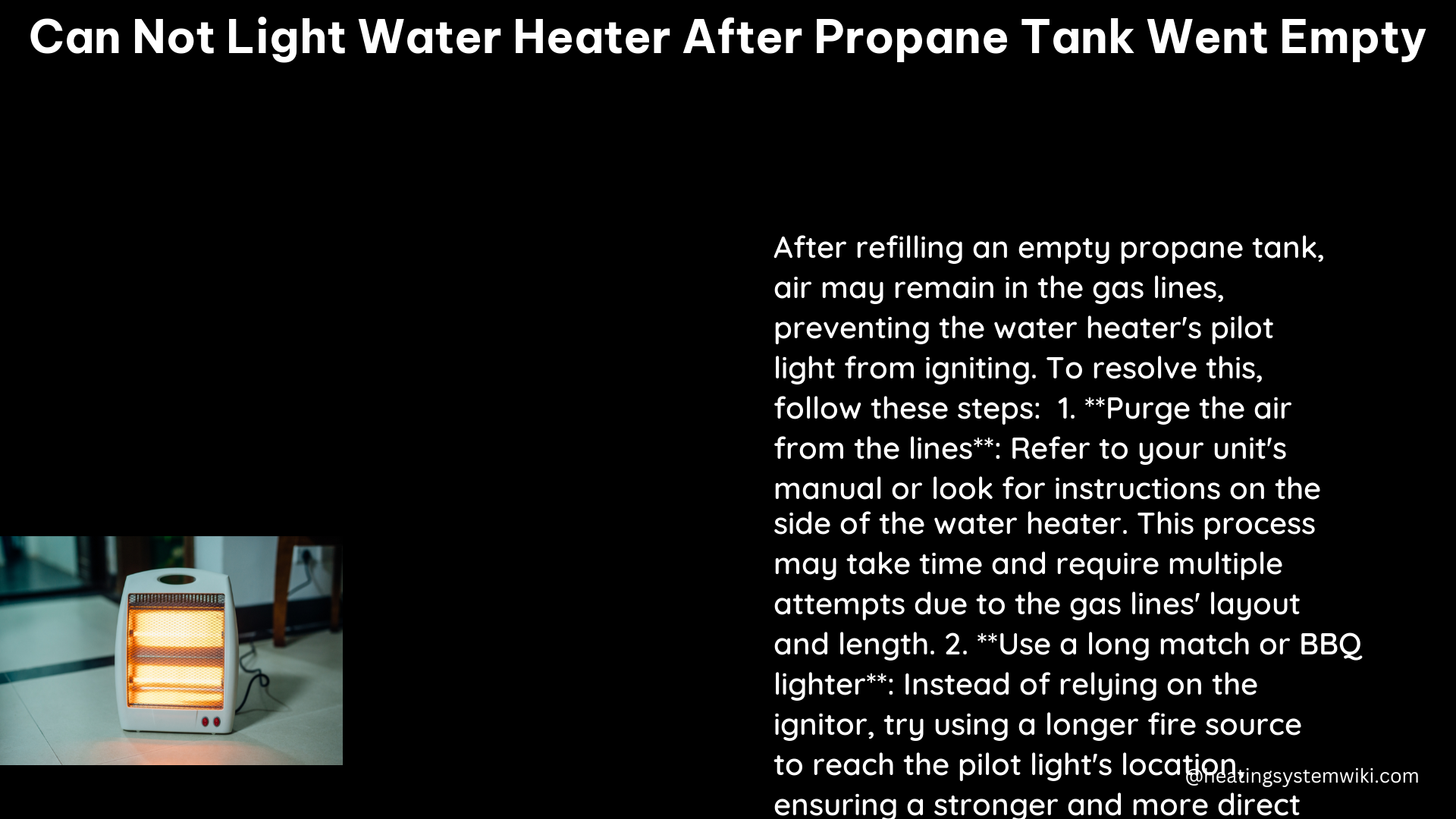If you’re unable to light your water heater after refilling your propane tank, you’re not alone. This issue is common and can be caused by several factors, including air in the gas lines, a faulty thermocouple, or a malfunctioning pilot light assembly. In this guide, we’ll explore the possible causes, technical specifications, and DIY solutions for this problem.
Possible Causes
Air in the Gas Lines
When a propane tank runs out of gas, air can enter the gas lines, preventing the pilot light from igniting. This is a common issue, and it’s essential to purge the air from the lines before attempting to relight the pilot.
Faulty Thermocouple
The thermocouple is a safety device that senses the heat of the pilot light and allows gas to flow to the burner. If it’s faulty or damaged, it may prevent the pilot light from staying lit. Thermocouples are typically made of two dissimilar metals joined at one end, with the other end placed in the flame of the pilot light. When heated, the thermocouple generates a small electrical current that opens the gas valve.
Malfunctioning Pilot Light Assembly
The pilot light assembly includes the thermocouple, pilot light, and gas valve. If any of these components fail, the pilot light may not ignite or stay lit. The pilot light is a small flame that stays lit continuously, igniting the main burner when needed. The gas valve regulates the flow of gas to the pilot light and burner, and it includes a manual override that allows you to light the pilot light manually.
Technical Specifications

Thermocouple
A thermocouple is a temperature-sensing device that generates a small electrical current when heated. It’s typically made of two dissimilar metals, such as copper and constantan, joined at one end. The other end is placed in the flame of the pilot light, which heats it and generates a current that opens the gas valve.
Thermocouples come in a variety of sizes and configurations, with common lengths ranging from 12 to 36 inches. The diameter of the thermocouple can also vary, with typical sizes ranging from 1/8 to 1/4 inch. The output voltage of a thermocouple can range from 10 to 50 millivolts, depending on the temperature of the pilot light flame.
Pilot Light
The pilot light is a small flame that stays lit continuously, igniting the main burner when needed. It’s typically located at the base of the water heater and is controlled by the gas valve. The size and shape of the pilot light can vary depending on the make and model of the water heater, but it’s generally a small, blue flame that’s visible through a small opening in the water heater’s casing.
Gas Valve
The gas valve regulates the flow of gas to the pilot light and burner. It includes a manual override that allows you to light the pilot light manually. The gas valve is typically located near the base of the water heater and is connected to the gas supply line.
The gas valve may have a variety of features, such as a safety shut-off mechanism that cuts off the gas supply if the pilot light goes out. Some gas valves also include a thermostat that allows you to adjust the temperature of the water heater.
DIY Solutions
Before attempting any DIY solutions, make sure to turn off the gas supply to the water heater and allow any residual gas to dissipate.
Purge the Air from the Gas Lines
To purge the air from the gas lines, follow these steps:
- Turn off the gas supply to the water heater.
- Locate the gas cock, which is usually located near the bottom of the tank.
- Turn the gas cock handle to the “off” position.
- Wait a few minutes for any residual gas to dissipate.
- Slowly turn the gas cock handle to the “pilot” position.
- Press and hold the pilot button while lighting the pilot light with a long match or lighter.
- Continue holding the pilot button for about a minute to allow the thermocouple to heat up.
- Slowly turn the gas cock handle to the “on” position.
Check the Thermocouple
If the thermocouple is faulty, you may need to replace it. To check the thermocouple, follow these steps:
- Turn off the gas supply to the water heater.
- Locate the thermocouple, which is typically located near the pilot light.
- Disconnect the thermocouple from the gas valve.
- Use a multimeter to test the thermocouple for continuity. The resistance should be between 20 and 30 ohms at room temperature.
- If the thermocouple has no continuity or the resistance is outside the recommended range, replace it.
Check the Pilot Light Assembly
If the pilot light assembly is malfunctioning, you may need to replace it. To check the pilot light assembly, follow these steps:
- Turn off the gas supply to the water heater.
- Locate the pilot light assembly, which is typically located at the base of the water heater.
- Disconnect the pilot light assembly from the gas valve.
- Inspect the assembly for any signs of damage or wear, such as a cracked or corroded thermocouple, a bent pilot light, or a malfunctioning gas valve.
- If the assembly is damaged or worn, replace it with a new one that’s compatible with your water heater model.
Safety Precautions
- Always turn off the gas supply to the water heater before attempting any DIY solutions.
- Never use an open flame to purge the air from the gas lines. Use a long match or lighter instead.
- Always use a long match or lighter to light the pilot light, and never use your bare hands.
- If you’re unsure about any of the steps or feel uncomfortable performing the repairs, consult a professional plumber or HVAC technician.
